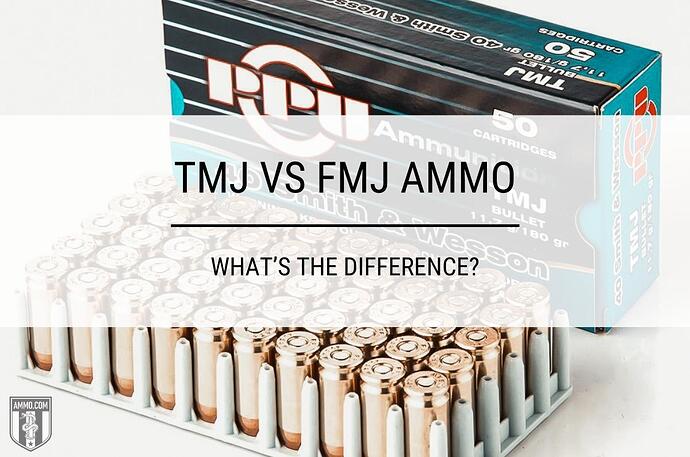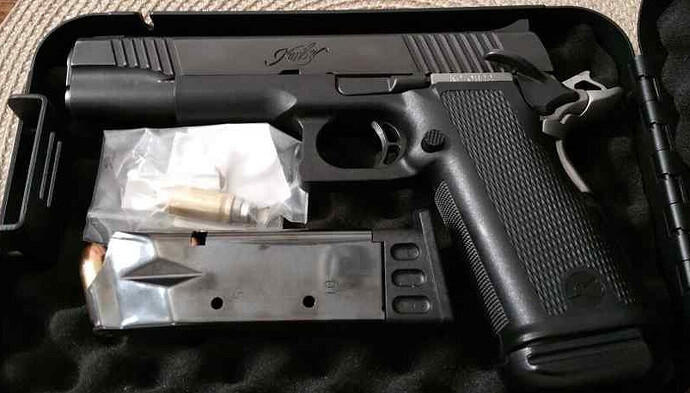If you’ve only spent a short amount of time shopping for target ammo, then you have probably already encountered two types of it: full metal jacket (FMJ), and total metal jacket (TMJ).
The two bullets are named almost identically – but does that mean they’re the same?
No. Although FMJ and TMJ bullets share the same applications (plinking, training, and target shooting), the TMJ has a feature the FMJ lacks: one which minimizes lead aerosolization during ignition.
What’s the Key Difference Between the TMJ and FMJ?
The FMJ bullet’s metal jacket does not shield the base of its lead core against hot, exploding propellant gasses. An FMJ therefore emits toxic lead gas during ignition.
The TMJ bullet’s metal jacket completely envelops its lead core. When the base of the TMJ is exposed to hot propellant gasses, the lead beneath its jacket doesn’t evaporate.
What Is Full Metal Jacket Ammo (FMJ)?
The advent of firearms with internal loading mechanisms posed a new problem. Conventional lead bullets are relatively soft, and therefore inclined to deform when they are chambered mechanically (as opposed to by hand).
Swiss engineer Col. Eduard Rubin developed the solution around 1882: the FMJ, which consists of a dense lead core and surrounding metal jacket (typically copper alloy or steel). Its rigid jacket enables the FMJ to forgo deformation as it feeds into the chamber. The FMJ’s jacket also eliminates lead-on-bore contact, thereby conserving accuracy by slowing the rate of barrel fouling.
The FMJ fabrication process is straightforward. Take a cup-shaped copper jacket, insert a lead core into it, run the two through a swaging die so as to make their shape and weight distribution uniform, and voila – an FMJ. It’s an ideal bullet for cost-effective target shooting with nearly any type of handgun or rifle, and it also satisfies the Hague Convention of 1899 (which imposes a moratorium on the use of expanding bullets, e.g. hollow points, for humanitarian purposes).
Why Was the Total Metal Jacket (TMJ) Bullet Developed?
Although it is simple, practical, and economical, the FMJ can be argued to have one major design flaw: the base of its lead core, which isn’t jacketed.
Solid lead evaporates at a relatively low temperature for a metal (3,182 °F). Brief exposure to exploding propellant therefore evaporates lead off the base of an FMJ, which has four undesirable outcomes.
- An FMJ’s base becomes slightly distorted during ignition. When propellant gasses don’t have a flat, even surface to exert their energy against, accuracy can suffer as a result.
- An FMJ produces lead gas which accumulates inside an indoor range as dust or residue.
- An FMJ produces lead gas which accumulates inside the barrel. This fouling makes the bore’s rifling less effective at its job, and harms accuracy as a result.
- Lead gas is toxic. Exposure to lead inside gun ranges is unlikely to sicken a casual shooter, although serious marksmen, law enforcement professionals, and range staff are all at heightened risk of lead poisoning…
…if they endure long-term exposure to FMJ bullets within the confines of a stuffy, poorly ventilated gun range, that is. But if they attend a range that requires TMJ ammo – as many do – then they’re in much better standing. To understand why, ask yourself the big question:
What Is Total Metal Jacket Ammo (TMJ)?
A TMJ bullet is manufactured very differently than an FMJ. Essentially, a fully formed lead core is submerged in an electrified chemical bath. There it is electroplated: joined with copper one atom at a time until it is encapsulated by a uniformly thick jacket.
The base of the TMJ’s core is totally enveloped. The intense heat of ignition is therefore incapable of vaporizing lead, which promotes a cleaner and healthier indoor training environment. The TMJ helps to conserve accuracy and shorten cleaning time by decelerating the rate of barrel fouling. It can also promote better accuracy by giving propellant gasses a more uniform surface to push against (noting that most shooters cannot discern such a minute benefit). Its uniformly concentric jacket may also enhance the TMJ’s gyroscopic stability, which would only benefit its accuracy even further.
The TMJ’s electroplated jacket isn’t without its shortcomings. First, it costs more to fabricate, which is why TMJ ammo usually costs more than FMJ alternatives (albeit not by very much). Second, it is possible for a ported barrel or compensator to slice a thin sliver off of a TMJ’s jacket prior to expulsion from the muzzle. If that sliver deflects back toward the shooter’s face at high velocity … well, you obviously don’t want that to happen to you.
Continue reading TMJ vs. FMJ Ammo: What’s the Difference? on Ammo.com

